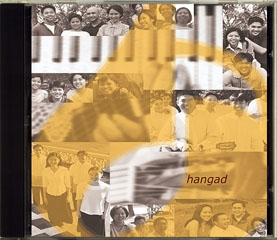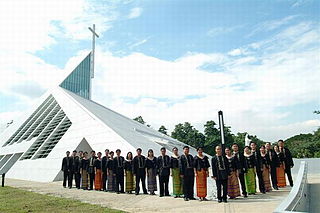
Vespro della Beata Vergine, SV 206, is a musical setting by Claudio Monteverdi of the evening vespers on Marian feasts, scored for soloists, choirs, and orchestra. It is an ambitious work in scope and in its variety of style and scoring, and has a duration of around 90 minutes. Published in Venice as Sanctissimae Virgini Missa senis vocibus ac Vesperae pluribus decantandae, cum nonnullis sacris concentibus, ad Sacella sive Principum Cubicula accommodata, it is sometimes called Monteverdi's Vespers of 1610.

American Pie is the second studio album by American singer-songwriter Don McLean, released by United Artists Records in October 1971. The folk rock album reached number one on the Billboard 200, containing the chart-topping singles "American Pie" and "Vincent". Recorded in May and June 1971 at The Record Plant in New York City, the LP is dedicated to Buddy Holly, and was reissued in 1980 minus the track "Sister Fatima". The album was released to much acclaim, later being included in the book 1001 Albums You Must Hear Before You Die.

A metrical psalter is a kind of Bible translation: a book containing a verse translation of all or part of the Book of Psalms in vernacular poetry, meant to be sung as hymns in a church. Some metrical psalters include melodies or harmonisations. The composition of metrical psalters was a large enterprise of the Protestant Reformation, especially in its Calvinist manifestation.

The San Miguel Philharmonic Orchestra (SMPO) was one of the two major performing arts groups (along with the San Miguel Master Chorale) under the San Miguel Foundation for the Performing Arts. As a young ensemble, its wide selection of works encompassing musical genres attests to its versatility and dynamism. Together with the SMMC, the SMPO aspired to produce and perform new orchestral works that will ensure the growth and development of Filipino music.

Psalm 137 is the 137th psalm of the Book of Psalms, beginning in English in the King James Version: "By the rivers of Babylon, there we sat down". The Book of Psalms is part of the third section of the Hebrew Bible, and a book of the Christian Old Testament. In the slightly different numbering system used in the Greek Septuagint and Latin Vulgate translations of the Bible, this psalm is Psalm 136. In Latin, it is known by the incipit, "Super flumina Babylonis". The psalm is a communal lament about remembering Zion, and yearning for Jerusalem while dwelling in exile during the Babylonian captivity.

Hangad is the self-titled debut album of the Philippine-based vocal ensemble Hangad. It contains the singles "Pananatili" and "Panunumpa", the latter of which was popularized by pop singer Carol Banawa.

Pasko Naming Hangad is the third album recorded by Philippine-based vocal ensemble Hangad. It is Hangad's first Christmas-themed album, containing original compositions and arrangements of some familiar Christmas songs.

The Easter Journey is the fourth album recorded by Philippine-based vocal ensemble Hangad. The album contains all-original songs intended to be performed for the Easter liturgy in the Roman Catholic Church. It also includes an almost complete set of songs for the Holy Mass, the Lord, Have Mercy prayer having been omitted.
The Jesuit Music Ministry (JMM) is a Philippines-based producer and publisher of music for use in the liturgy of the Roman Catholic church. It also manages a group of artists and composers, whose works are widely used in the liturgy of the Holy Mass in the Philippines. It is based in the Jesuit Ateneo de Manila University in Quezon City.

"Bayan Ko" is one of the most recognizable patriotic songs of the Philippines. It was written in Spanish by the revolutionary general José Alejandrino in light of the Philippine–American War and subsequent American occupation, and translated into Tagalog some three decades later by the poet José Corazón de Jesús.

A Wish for Christmas is the fifth album recorded by Philippine-based vocal ensemble Hangad. It is also the group's second Christmas album, the first being Pasko Naming Hangad. It is Hangad's shortest album to date, with four tracks.
Rev Fr Eduardo Pardo Hontiveros, SJ, also known as "Fr. Honti", was a Filipino Jesuit composer and musician, best known as an innovative hymnwriter behind popular Philippine liturgical music.

The Bukas Palad Music Ministry is a Roman Catholic, contemporary worship musical group in the Philippines that composes, records, and performs original religious music. Since 1986, Bukas Palad has recorded over a dozen albums with the Jesuit Music Ministry of Jesuit Communications Foundation, a ministry of the Philippine Province of the Society of Jesus, based in Ateneo de Manila University. The group has performed in over a hundred solo concerts across the country and overseas in Japan, Hong Kong, the United States, and Canada.
John Lawrence Kelsall was a British composer, conductor and lecturer.
Richard Collins St. Clair is an American composer, pedagogue, poet and pianist.
Most of Johann Sebastian Bach's extant church music in Latin—settings of the Mass ordinary and of the Magnificat canticle—dates from his Leipzig period (1723–50). Bach started to assimilate and expand compositions on a Latin text by other composers before his tenure as Thomaskantor in Leipzig, and he continued to do so after he had taken up that post. The text of some of these examples by other composers was a mixture of German and Latin: also Bach contributed a few works employing both languages in the same composition, for example his early Kyrie "Christe, du Lamm Gottes".
Joel Magus P. Navarro is a Filipino-American conductor and music educator. He is one of the Philippines' most esteemed choral conductors. He is also a composer, singer, arranger, choral clinician, writer, producer, music minister, author, and book editor.

Pietro Torri's Magnificat in C major, a setting of the biblical Canticle of Mary, the Magnificat, for double choir and orchestra likely dates from the 1690s. The work is scored for two SATB choirs, two trumpets, bassoon, strings and basso continuo. Its music opens with an instrumental introduction (sinfonia). Most of the composition's movements are either choral movements, in which all singers and instruments participate, or duets for two singers and a more limited instrumental accompaniment.












